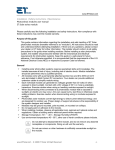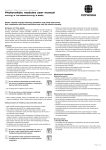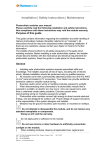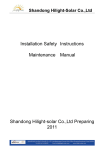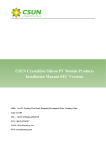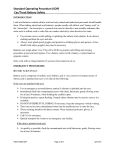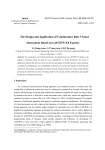Download ET Solar Installation Guide
Transcript
www.ETSolar.com Installation | Safety instructions | Maintenance Photovoltaic modules user manual ET Solar series module Please carefully read the following installation and safety instructions. Non-compliance with these instructions may void the module warranty. Purpose of this guide This guide contains information regarding the installation and safe handling of ET Solar photovoltaic modules (hereafter referred to as "modules"). All instructions should be read and understood before attempting installation. If there are any questions, please contact your dealer or ET Solar for further information. The installer should conform to all safety precautions in the guide when installing modules. Before installing a solar photovoltaic system, the installer should become familiar with the mechanical and electrical requirements for photovoltaic systems. Keep this guide in a safe place for future reference. General 9 9 9 9 9 9 9 9 Installing solar photovoltaic systems requires specialized skills and knowledge. The installer assumes all risk of injury, including risk of electric shock. Module installation should be performed only by qualified persons. All modules come with a permanently attached junction box and #12 AWG (4 mm²) wire terminated in standardized PV connectors. Your dealer can provide additional extension cables to simplify module wiring. Each individual module can generate DC voltages greater than 30 volts (V) when exposed to direct sunlight. Contact with a DC voltage of 30 V or more is potentially hazardous. Exercise caution when wiring or handling modules exposed to sunlight. When disconnecting wires connected to a photovoltaic module that is exposed to sunlight, an electric arc may occur. Arcs can cause burns, start fires or otherwise create safety problems. Exercise caution when disconnecting wiring on modules exposed to sunlight. Photovoltaic solar modules convert light energy to direct-current electrical energy, and are designed for outdoor use. Proper design of support structures is the responsibility of the system designer and installer. Modules may be ground mounted, pole mounted, or mounted on rooftops. Do not apply paint or adhesive to the module. When installing modules, observe all applicable local, regional and national codes and regulations. Obtain a building and/or electrical permit where required. Do not attempt to disassemble the module, and do not remove any attached nameplates or components. Doing so will void the warranty. Do not use mirrors or other hardware to artificially concentrate sunlight on the module. www.ETSolar.com © 2009 ET Solar All Right Reserved -1- www.ETSolar.com Safety precautions for installing a solar photovoltaic system 9 9 9 9 9 Solar modules produce electrical energy when exposed to sunlight. DC voltages may exceed 30V on a single exposed module. Only connect modules with the same rated output current in series. If modules are connected in series, the total voltage is equal to the sum of the individual module voltages. Only connect modules or series combinations of modules with the same voltage in parallel. If modules are connected in parallel, the total current is equal to the sum of individual module or series combination currents. Keep children well away from the system while transporting and installing mechanical and electrical components. Completely cover all modules with an opaque material during installation to prevent electricity from being generated. Do not wear metallic rings, watchbands, ear, nose, or lip rings or other metallic devices while installing or troubleshooting photovoltaic systems. Use appropriate safety equipment (insulated tools, insulating gloves, etc) approved for use on electrical installations. 9 9 9 9 9 Observe the instructions and safety precautions for all other components used in the system, including wiring and cables, connectors, DC-breakers, mounting hardware, inverters, etc. Use only equipment, connectors, wiring and mounting hardware suitable for use in a photovoltaic system. Always use the same type of module within a particular photovoltaic system. Under normal operating conditions, PV modules will produce currents and voltages that are different than those listed in the date sheet. Data sheet values are applicable at standard test data. Short-circuit current and open-circuit voltages should be multiplied by a factor of 1.25 when determining component voltage ratings, conductor ampacity, fuse sizes and size of controls connected to the module or system output. An additional multiplying factor of 125 percent (80 percent de-rating) may be applicable. General installation notes 9 9 9 9 9 9 Drainage holes must not be covered with parts of the mounting system. The junction box has a breather port which must be mounted facing downward and cannot be exposed to the rain. The junction box should be on the higher side of the module when it is mounted in order to orient the breather port correctly. Do not lift the module by grasping the module's junction box or electrical leads. Do not stand or step on module. Do not drop the module or allow objects to fall on the module. Do not place any heavy objects on the module. Inappropriate transport and installation may damage the module glass or frame. Mechanical Installation Selecting the location 9 9 Select a suitable location for installation of the module. For optimum performance, the module must be facing true south in northern latitudes and true north in southern latitudes. www.ETSolar.com © 2009 ET Solar All Right Reserved -2- 9 9 9 www.ETSolar.com For detailed information on optimal module orientation, refer to standard solar photovoltaic installation guides or a reputable solar installer or systems integrator. Shading on the module will reduce electricity production. Do not install the module near equipment or in locations where flammable gases can be generated or collected. Selecting the proper mounting structure and hardware 9 9 9 9 9 9 Observe all instructions and safety precautions included with the mounting system to be used with the module. Do not drill holes in the glass surface of the module. Doing so will void the warranty. Do not drill additional mounting holes in the module frame. Doing so will void the warranty. Modules must be securely attached to the mounting structure using four mounting points for normal installation. If heavy wind or snow loads are anticipated, additional mounting points should also be used. Please see the drawing below. Load calculations are the responsibility of the system designer or installer. The mounting structure and hardware must be made of durable, anti-corrosion and UV-resistant material. Mounting methods 1. Mounting with Bolts 9 9 9 The module must be attached and supported by at least four bolts through the indicated mounting holes. Most installations will use the four inner mounting holes on the module frame. Depending on the local wind and snow loads, additional mounting points may be required. 2. Mounting with Clamping Hardware 9 If module clamps are used to secure the module, the torque on the clamp bolt should be around 8–10 Nm. 9 A minimum of four module clamps should be used, two on each long frame side, in the general clamping areas denoted by the wide arrows on the drawing. 9 Depending on the local wind and snow loads, additional module clamps may be required. All dimensions in mm. www.ETSolar.com © 2009 ET Solar All Right Reserved -3- www.ETSolar.com 3. Other 9 Other mounting methods are acceptable as long as the minimum requirement as described under 2. Mounting with clamping hardware are met. Electrical Installation Grounding 9 9 9 9 9 9 All module frames must be properly grounded. Observe all local electric codes and regulations. A bonding or toothed washer is required to make proper and reliable electrical grounding connection with the anodized aluminum frame. Devices listed and identified for grounding metallic frames of PV modules are permitted to ground the exposed metallic frames of the module to grounded mounting structures. Consider using a lay-in lug, rated for outdoor use, if the module grounding conductor is to be larger than #10 AWG. When using lay-in lugs, the grounding conductor should be inserted into the opening indicated in the figure, and secured using the set screw. General electrical installation 9 9 9 9 9 9 9 Do not use modules of different configurations in the same system. This module is supplied with standardized connectors for electrical connections. Refer to local code to determine appropriate types and temperature ratings of conductors. Wiring should be #12 AWG, 4 mm² (minimum) and must be temperature rated at 90 °C (minimum). Completely cover system modules with an opaque material to prevent electricity from being generated while disconnecting conductors. Refer to local code to determine over current, conductor ampacity and size requirements. Installation shall be in accordance with local code. For best performance, ensure that positive and negative DC wires run closely together avoiding loops. WARNING! Electrical shock hazard! Do not touch bare conductors or other potentially energized parts. Maintenance ET Solar recommends the following maintenance items to ensure optimum performance of the module: 9 Clean the glass surface of the module as necessary. Use water and a soft sponge or cloth for cleaning. A mild, non-abrasive cleaning agent can be used if necessary. Do not use dishwasher detergent. 9 Electrical and mechanical connections should be checked periodically by qualified personnel to verify that they are clean, secure and undamaged. 9 Check the electrical and mechanical connections periodically to verify that they are clean, secure and undamaged. 9 Problems should only be investigated by qualified personnel. www.ETSolar.com © 2009 ET Solar All Right Reserved -4- www.ETSolar.com 9 Observe the maintenance instructions for all other components used in the system. Shutting down the system 9 9 9 Completely cover system modules with an opaque material to prevent electricity from being generated while disconnecting conductors. Disconnect system from all power sources in accordance with instructions for all other components used in the system. The system should now be out of operation and can be dismantled. In doing so, observe the all safety instructions as applicable to installation. Electrical ratings of the concerned modules: Pls refer to each kinds of ET module datasheet. Disclaimer of liability Because the use of this manual and the conditions or methods of installation, operation, use and maintenance of photovoltaic products are beyond ET Solar's control, ET Solar does not accept responsibility and expressly disclaims liability for loss, damage, or expense arising out of or in any way connected with such installation, operation, use or maintenance. No responsibility is assumed by ET Solar for any infringement of patents or other rights of third parties, which may result from use of the PV product. No license is granted by implication or otherwise under any patent or patent rights. The information in this manual is based on ET Solar's knowledge and experience and is believed to be reliable, but such information including product specification (without limitations) and suggestions does not constitute a warranty, expressed or implied. ET Solar reserves the right to change the manual, the product, the specifications, or product information sheets without prior notice. Information about manufacturer: ET Solar China 24F, A2 World Trade Center Mansion, 67 Shanxi RD, Nanjing 210009, China Tel: 86 25 86898096 86898098 Fax: 86 25 86898097 E-mail: [email protected] Please consult your dealer or the manufacturer concerning the warranty of your modules. If you have any further questions, your dealer and ET Solar will gladly assist you. Subject to technical modifications without notice. 2009 © ET Solar Group. www.ETSolar.com © 2009 ET Solar All Right Reserved -5-





